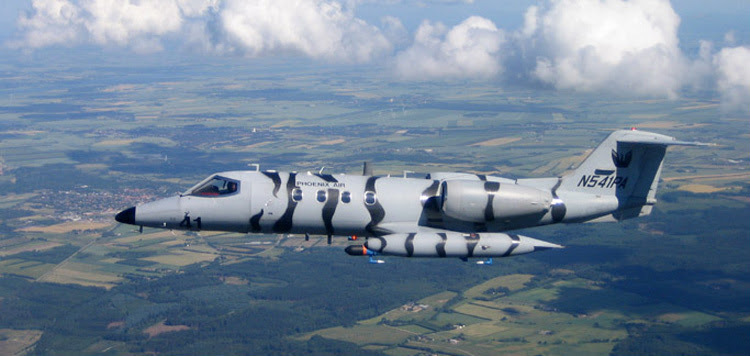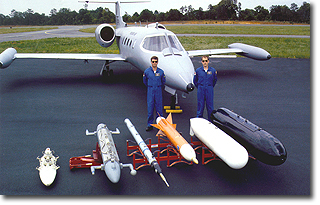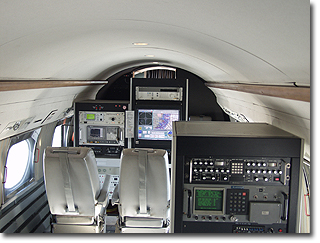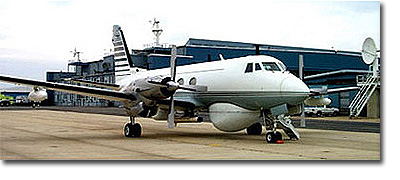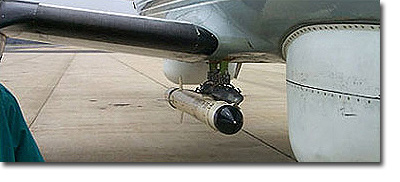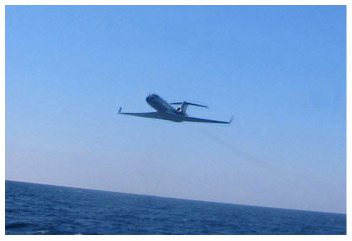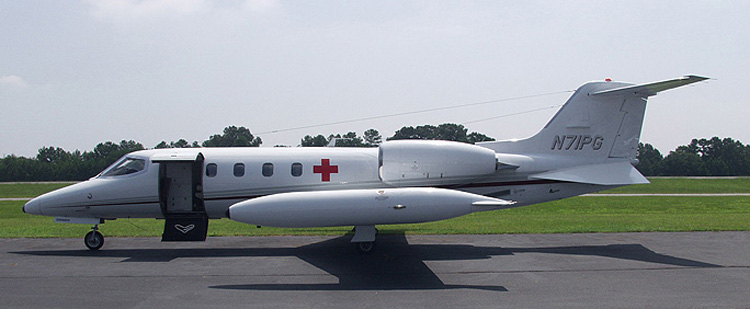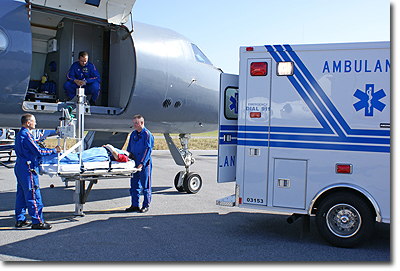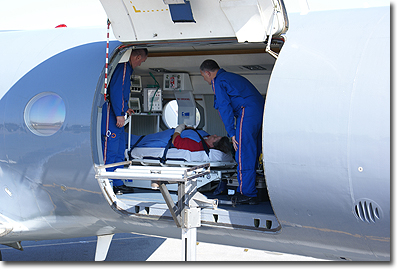Phoenix
Air Fleet Military Ops, |
From Dr Patricia Doyle PhD |
|
Phoenix Force aircraft can be equipped with any of the following Electronic Warfare systems:
Radar jamming frequency capabilities include “B” thru “J” for under-wing external mounted pods and “I-J” for internal suites. External Hard Points and Pod Carriage
All Phoenix Force Learjets and Gulfstream G-I special missions aircraft have hard points installed to allow for the carriage of pods, aerial towed targets and/or carriage of the Northrup BQM-74 Chukar Aerial Target Drone. The Learjets have hard points installed under each aircraft wing capable of attaching 14-inch Ejector Rack Units (ERU), and the Gulfstream G-I’s have a set of hard points installed on the aircraft belly capable of attaching either the 14-inch or 30-inch Ejector Rack Units. Multiple cables (coax, power, data) are installed from inside the aircraft’s pressurized fuselage through the pressure wall and out to the hard points, enabling external pods or other array to be “plugged in” while hanging on station. This allows pod control and mission power to be generated inside the aircraft’s pressurized environment. With the installation of a Triple External Rack (TER) onto an Ejector Rack Unit (ERU), multiple external pods can be carried on a single hard point location. Phoenix Air aircraft can carry any of the following external pods:
Electronic Warfare Phoenix Force aircraft are equipped with internal and external state-of-the-art electronic jamming equipment optimized for modern pulse Doppler fire control systems. All Phoenix Air special missions systems have multiple noise and deception techniques. The company has superior logistics support with ample spares capability to meet all mission requirements anywhere in the world. Phoenix Air flight crews have extensive training in threat simulation and electronic attack profiles. All pilots are formation flying qualified, low-level flight qualified and proficient in bomber/fighter tactics. Phoenix Air has over 20-years experience and more than 200,000 flight hours in support of military training and R&D requirements. Senior and middle managers have 100-plus years of senior military experience in all areas of flight and ground operations. Phoenix Air’s mission success record is 99% including all overseas operations.
Electronic Warfare Aircraft for Training
Phoenix Air’s superior performance during a highly successful 10-year run from 1999 to 2009 providing sophisticated electronic warfare services to the Navy under the Commercial Aircraft Electronic Combat Services Program (CAECSP) was recognized by the U.S. Navy awarding Phoenix Air a 5-year contract under the newly designated Electronic Warfare Aircraft for Training (EWAT). EWAT—the follow-on program to CAECSP—is a Navy requirement for an airborne high-power radar jamming aircraft. Phoenix Air won this competitively bid contract by offering two highly modified Gulfstream G-I aircraft with crew, equipment and maintenance for high-power “A” thru “J” band radar jamming and communications jamming. Capable of more than five-hours on station, the CAECSP Gulfstream G-I’s train airborne and shipboard fleet units to achieve and maintain EW combat superiority by using tactical procedures and concepts, and measuring and evaluating the results in support of U.S. Navy, Joint Force and NATO militaries worldwide. Outfitted with the latest suites of avionics and navigation equipment, the EWAT aircraft are capable of providing worldwide radar and communications jamming to an operator-selectable list of radar systems. Each EWAT aircraft has the following capabilities:
EWAT Operator Systems
EWAT Radar Jamming
EWAT Communications Jamming
CAECSP Pod Carriage
Range Clearing
Phoenix Air Group, Inc. has been awarded a Naval Air Systems Command 5-year multi-million dollar contract to provide airborne maritime range surveillance for the Missile Defense Agency (MDA) and other Department of Defense range facilities. The company is using a highly modified G-IIB aircraft (see aircraft pictured above) equipped with the Raytheon SeaVueTM coastal and sea surveillance radar along with a Gulfstream G-III jet aircraft with high definition APS-127 Surface Search Radar systems. These aircraft provide maritime sea surveillance during all MDA missile launches conducted at the Pacific Missile Range Facility Barking Sand, HI. The services provided are in support of the Terminal High Altitude Area Defense (THAAD) System and MDA Joint Test Mission (JTM) missile launches out of Vandenberg AFB, California. Additionally, a specially equipped Gulfstream G-I turbo prop aircraft with digital RDR-1500B Surface Search Radar is available to supplement any maritime range surveillance taskings. Phoenix Air complements this equipment with flight crews and radar operators highly trained in Range Clearing procedures.
Aircraft Customization Phoenix Air’s highly experienced Maintenance, Avionics and Special Missions personnel have years of experience in installing existing Government Furnished Equipment (GFE), developing interfaces between client-supplied equipment and aircraft operations systems, and developing new systems to support mission requirements. Phoenix Air is staffed by highly competent hands-on technicians, using CADS systems, bench experimentation, sheet metal workers, designers, specialized sub contractors and more to integrate technology into existing airframes. In the case of the CAECSP aircraft, the two corporate Gulfstream G-I aircraft were completely disassembled in Phoenix Air’s maintenance facilities and re-built incorporating major modifications to the fuselage and wings to accommodate various radomes, external pods and antennas. Learjet “Gray Birds” have similarly been converted from former corporate aircraft to highly specialized military contracted aircraft. In additional to DOD clients, Phoenix Air technicians have customized aircraft for cargo operations, U.S. Weather Service for atmospheric testing, U.S. Forest Service for aerial photography and Georgia Tech Research Institute for experimental pod carriage. Learjet Air Ambulance
Each Phoenix Air dedicated air ambulance Learjet aircraft has a 36-inch wide passenger door for ease of stretcher loading, one Spectrum Aeromed Life Support System for patient care, internal medical oxygen storage system, the latest Honeywell TFE-73-2C-2B aircraft engines, and RVSM for international operations. More information about our Learjet Ambulance Fleet Phoenix Air Ambulance
Commission on Accreditation of Medical Transport Systems The Commission on Accreditation of Medical Transport Systems (CAMTS), the gold seal for air ambulance operators, accredits Phoenix Air Group’s air ambulance operations. Developed exclusively by and for the air medical transportation industry, this national accreditation organization focuses on quality of patient care and safety of the transport environment through an in-depth on-site review by professional CAMTS surveyors. CAMTS accredits both rotor wing (helicopter) and fixed wing (airplane) operators. The U.S. DOD requires CAMTS accreditation for top tier commercial air ambulance companies transporting DOD personnel and their dependents. Multi Patient VIP Multiple Passenger GIII Air Ambulance: Phoenix Air owns and operates the only two Gulfstream G-III business jets in the world with cargo doors. Each has been outfitted with a Critical Care “package” which can be quickly installed and customized for single or multiple patients with attending medical staff.
These aircraft are the finest and most efficient emergency response air ambulance aircraft operating in the world:
|
| Donate to Rense.com Support Free And Honest Journalism At Rense.com | Subscribe To RenseRadio! Enormous Online Archives, MP3s, Streaming Audio Files, Highest Quality Live Programs |
